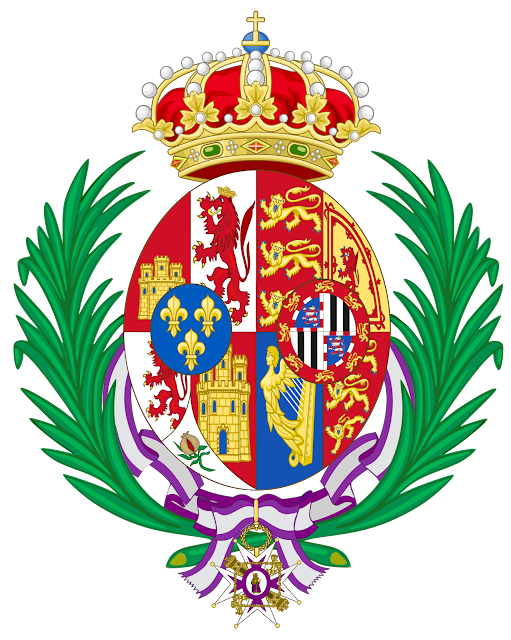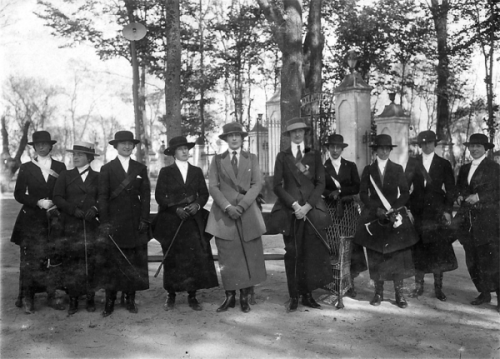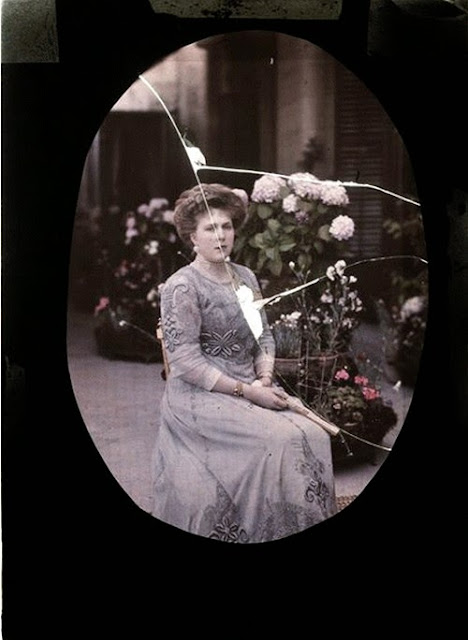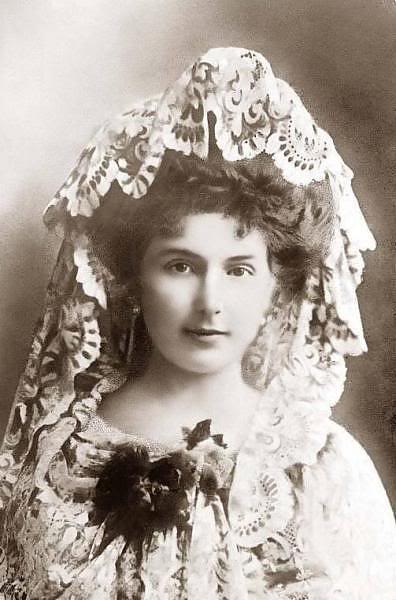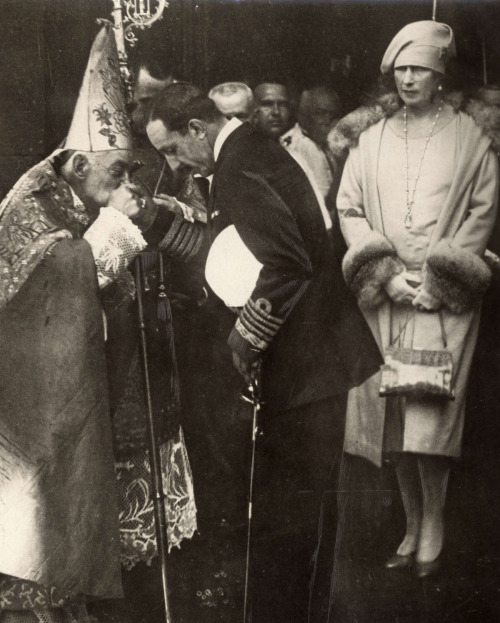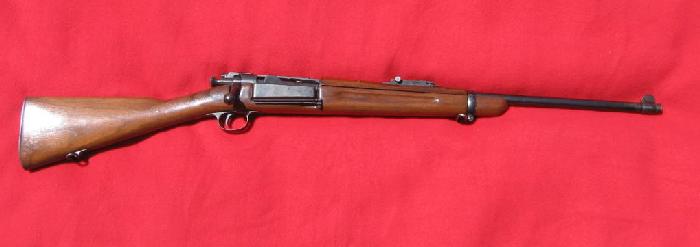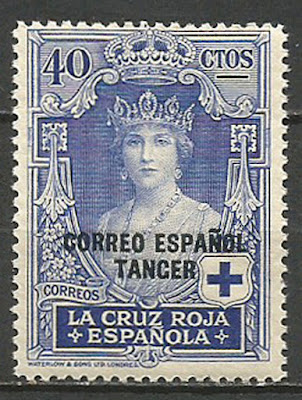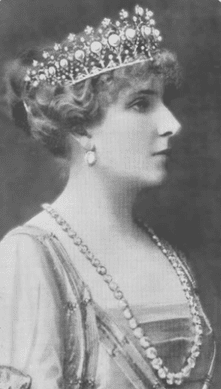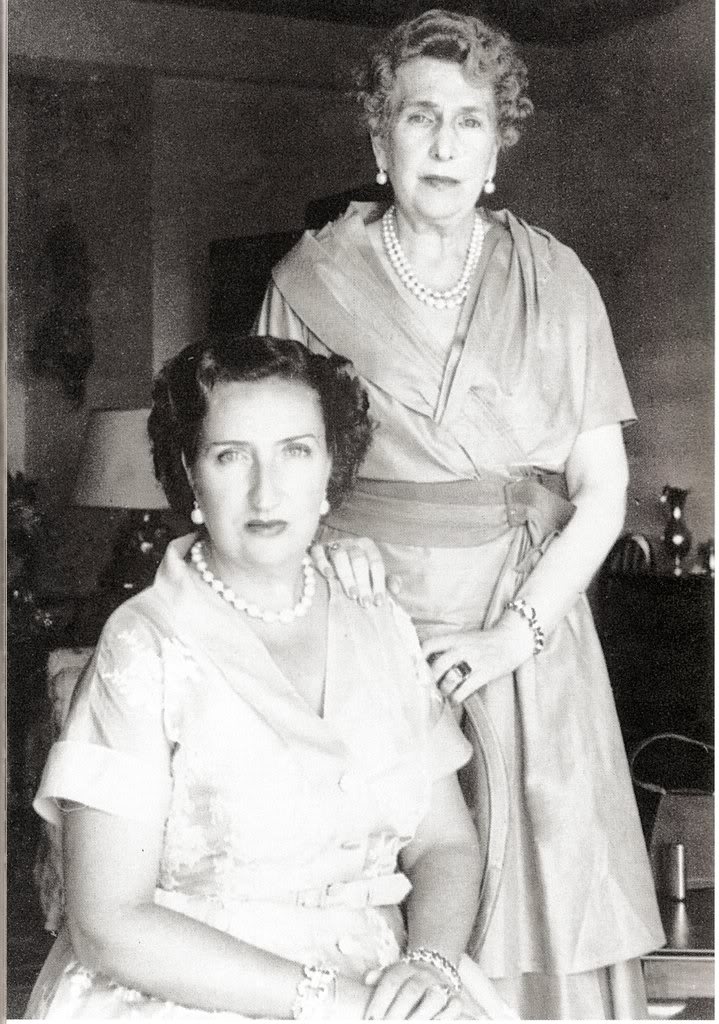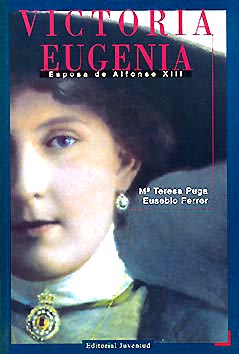To hear the musical soundtrack, click on the "Somewhere in Time" screen
Para escuchar la banda sonora, haga clic en la pantalla de "Somewhere in Time"
Pour bande son , cliquez sur l'écran " Somewhere in Time "
Чтобы услышать музыкальное сопровождение нажмите на экране " Где-то во времени "
Für Soundtrack, klicken Sie auf " Somewhere in Time " Bildschirm
"לשמוע את הפסקול המוזיקלי , לחץ על המסך " אי שםבזמן
要收听音乐的配乐,点击“时光倒流”屏幕上
心臓へのサウンドトラックは、 「どこかの時間 "の画面をクリックしてください。
साउंडट्रैक सुनने के लिए, "कहीं में समय" की स्क्रीन पर क्लिक करें
Note errors on invitation: King Alfons(o) XII(I)
Coat of Arms of Queen Ena
Queen Ena's Monogram
Note: Interesting trivia. V= 5 in Latin numerals. E= 5th letter of the alphabet
www.astrotheme.com/astrology/Victoire_Eugénie_de_Battenberg
Queen Ena's Astrological Chart
Seventy-five years before Princess Diana, there was Queen Ena
It's ironic that Britain should lay claim to Queen Victoria Eugenia (Ena) given how much mockery and derision it exhibits towards Germans and Scots in programs such as "Blackadder" and "Fawlty Towers", etc. After all, Queen Ena was of both German and Scottish origin. She was born in Balmoral Castle, Aberdeenshire, Scotland. The Battenbergs' ancestral home is Bavaria, Germany and they did not move to Britain until 1901; her mother, Princess Beatrice of Britain and Ireland, was the daughter of German-born Prince Albert of Sachsen-Coburg und Gotha, an area which today straddles Bavaria and Thuringia, and of course, Queen Victoria. Queen Victoria's own mother, Princess Victoria of Sachsen-Coburg und Saalfeld, was also German-born. Queen Ena's father, Colonel/Prince Heinrich Moritz of Battenberg, was born in Milan, Lombardy-Venetia (modern day Italy), and he was the son of Prince Alexander Josef of Hessen und bei Rhein, and Julia Therese von Hauke, both also ethnic Germans. So at times I think Britain's claim to Queen Ena being "British" is akin to someone claiming Charleze Theron is Black because she happened to be born in Benoni, South Africa, lol.
Eighty (80) years before Princess Diana's much celebrated efforts on behalf of philanthropic causes, there was Queen Victoria Eugenia (Princess Ena of Battenberg), only recognized for her much greater efforts in her adopted country of Spain. One of the items on my "Bucket List" is to live to see a movie made about this amazing woman's life. If the past is any indication, I sincerely doubt it will ever be made, unless the project would be undertaken by someone like director Clint Eastwood, due to the irrational hatreds and prejudices that permeate the Hollywood atmosphere.
I believe there would be significant interest in such a movie world-wide, not just from the human interest angle, but from an educational angle- a means to bring a chapter of history, long-suppressed, out of the shadows. The movie could incorporate, as a note before credits are flashed, that a Royal Decree made during the reign King Alfonso XIII and Queen Ena (in 1924), which bestowed Spanish citizenship to all persons of the Jewish Faith tracing their origins to Spain, was used by Spanish ambassadors all over Europe, throughout World War II, to rescue over 50,000 persons of the Jewish Faith from Hitler's murderous grasp. Spanish ambassadors either recovered their stolen property or had Nazi Germany pay them repairs. The persons thus rescued were issued Spanish passports and transported to Spain for their safety. And finally, that in 1963, the B'nai B'rith recognized this almost unknown action by Generalisimo Francisco Franco and Spain, and awarded both a "Good Conduct Award" for "good treatment of Jews during World War II". I do not recall any mention of King Alfonso XIII, or Queen Ena, at the time the award was made. King Alfonso XIII and Queen Ena were the very persons directly responsible for the existence of the Royal Decree/Law that Generalisimo Franco used to perform this life-saving mission.
Queen Ena was a strong, loving, virtuous, courageous, caring, intelligent woman, devoted mother, and eventually, equally devoted, Grandmother, and Great Grandmother. May her next life be much more happy and kind to her than this one was.
One of my favorite photographs of Queen Ena as a Mother, not only because of the image of maternal tenderness and devotion to her child, but because the resemblance to someone I loved dearly is uncanny.
 Queen Ena's handwriting (at age 18 1/2) from a Thank You note to Lady Seymour for wedding present
Queen Ena's handwriting (at age 18 1/2) from a Thank You note to Lady Seymour for wedding present And in later years- Thank You note for birthday gift
Princess Ena at 16, June 8, 1904
Princess Ena at 16, June 19, 1904
Princess Ena being wooed persistently at Biarritz by King Alfonso
Princess Ena and King Alfonso after engagement announced at Biarritz
Were image-makers and/or photographer going for a Virgin Mary-like look for the future Queen in order to further increase the enthusiasm and affection the Spanish people felt for her?
Princess Ena boarding coach enroute to Church/Monastery of San Geron imo

Princess Ena (left) ascending steps of Church/Monastery of San Geron imo on way to altar
Princess Ena's & King Alfonso's Wedding Ceremony
"Punch" Cartoon Celebrating the Wedding of Princess Ena of Battenberg & King Alfonso XIII of Spain
Princess Ena of Battenberg's and King Alfonso XIII's Wedding Cake, because there are always those interested in things like wedding cakes, gowns, jewelry, etc.
The Royal Celebratory Ball of the Wedding of Princess Ena and King Alfonso
The new Queen Ena and King Alfonso XIII at their honeymoon at "La Granja"
The new Queen and King Alfonso at "La Granja"
Queen Ena, in white dress, her mother?, Princess Henry, and King Alfonso 1906
Queen Ena on the cover of Nuevo Mundo (New World) magazine
WARNING: To anyone who may be contemplating paying thousands of Euros for one such note, the person offering it for sale recently bought two (2), one for under ONE (1) Euro, and the other for ONE (1) Euro and change.
ADVERTENCIA: A cualquier persona que este' contemplando pagar miles de Euros por uno de estos billetes, el vendedor que ahora los ofrece a la venta compro' recientemente dos (2) de estos billetes, uno (1) por menos de un (1) Euro, y el otro por un (1) Euro y cambio.
Queen Ena profiled in The Illustrated London News 10 days after her wedding
Queen Ena and King Alfonso attending a Mass to pray for the health of Royal Heir, Prince Alfonso of Asturias
Queen Ena, King Alfonso and members of the Battenberg family, 1910
Another favorite photo of Princess Ena at 18, spending a chaperoned 3-day getting-to-know-you weekend with King Alfonso XIII at Biarritz.
Large photo above and this one, then Princess Ena and King Alfonso XIII on a chaperoned 3-day romantic getting-to-know-you get-away to Biarritz.
Princess Ena meeting her uncle, King Edward of Britain, at Biarritz
First meeting between Princess Ena of Battenberg and King Alfonso XIII of Spain, outside of Britain, and the official beginning of their courtship for marriage.
Queen Ena and King Alfonso XIII, as recent newlyweds, at right
Queen Ena at function in Palacio de Viana with King Alfonso. Note here the distance the King is already putting between himself and Queen Ena in public.
Queen Ena, King Alfonso and members of the Battenberg family in the United Kingdom
Queen Ena at Soto Mozanaque the Estate of the Duke of AlbuRquerque
Queen Ena and the Countess del Puerto
Queen Ena with marquise de Carisbrooke
Queen Ena and King Alfonso at the Hotel Palace
Queen Ena and King Alfonso with workers of automobile manufacturing plant at Guadalajara, Spain in 1920
Queen Ena, at far right, with King Alfonso during a break from a Polo Match in which he was participating
Queen Ena and King Alfonso at their son's Alfonso's (Prince of Asturias) graduation
Queen Ena with Princess Beatriz January 14, 1914
This is the same photo as above, but I was able to repair it a bit using
Corel's PaintShop Pro X5. Any attempt at repairing the crack on her
beautiful face, though, resulted in hideous deformation- so I had to leave
it alone. Perhaps someone with more talent, experience, better software
will be able to fix that as well.
Queen Ena with Alfonso, Prince of Asturias in stroller, and Infante Jaime in her arms.
Queen Ena with Prince of Asturias Alfonso and Infante Jaime
Queen Ena and King Alfonso with their first child, Alfonso, Prince of Asturias, born May 10, 1907, in a photo autographed by both and personally dedicated, dated August 1907
Queen Ena in sassy pose
Queen Ena with then newborn Infante Juan, who would later become the Count
of Barcelon, and father to the future King of Spain, Juan Carlos I.
Young Princess Ena, second from right standing, at a family gathering of the Battenbergs. Seated, of course is Queen Victoria of Britain. To the extreme left of the photo is Princess Louise doing the reading. Princess Thora of Schleswig-Holstein, Bavaria, Germany, the ancestral land of the Battenberg family, is to Queen Victoria's and Princess Ena's left. To the right of both Queen Elizabeth and Princess Ena is Princess Beatrice (Henry) Battenberg. Princess Ena was said to be Queen Elizabeth of England's favorite granddaughter.
Princess Ena as a teen with Grandmum Queen Victoria and Princess Alexandra of Edinburgh
Princess Ena, standing at left, with Queen Victoria, her mom Princess Henry and
her cousins Princess Beatrice and Prince Henry of Britain
Princess Ena with Queen Victoria her grandmum, Elizabeth, her mom Princess Henry, and cousins Princess Beatrice and Prince Henry of Britain
Princess Ena with Cousins, Princes Alexander, Leopold and Maurice, at 11 1/2, 1899
Princess Ena with cousin, Princess Mary Elizabeth of Eibach, Bavaria, Germany
Princess Ena with Princes Alexander, Leopold and Maurice
Princess Ena with Princess Alexandra of Edinburgh, Scotland
Princess Ena with cousin Princess Thora, of Schleswig-Holstein, Bavaria
Princess Ena as pre-teen with Grandmum Queen Victoria
Princess Ena, at age 9, with cousins, Princes Alexander (seated), Leopold and Maurice.
Princes Leopold and Maurice were to die at a very young age, 33 and 23, respectively.
Princess Ena of Battenberg and cousin, Prince Alexander of Battenberg
Princess Ena (left) with Princesses Alice of Battenberg, Patricia & Margaret of Connaught
Princess Ena with Queen Victoria, Edward Duke of Windsor, Queen Mary,
King George V, Princess Henry of Battenberg
Princess Ena on the pony given to her by her grandmum, Queen Victoria of Britain
Colorization courtesy of Ms. Linnea-Rose
Princess Ena-news of injury due to fall from her pony February 10, 1894, at age 9
Ooops! Someone misspelled BattenbErg !
Princess Ena at four years of age

Princess Ena on her father's knee, Prince Henry of Battenberg (title derived from his marriage to Princess Henry of Battenberg)
Princess Ena with cousins Princess Helena and Prince Henry of Battenberg
Princess Ena with cousins Princesses Helena and Beatrice of Britain
Colorization by Ms. Linnea Rose
Princess Ena, seated in wicker chair, with Queen Victoria
Princess Ena with Princess Beatrice of Britain
Princess Ena at 5 1/2 years of age
Princess Ena 6 years of age
Princess Ena (angry-looking munchkin on the left) with cousins Princess Beatrice and Prince Henry of Battenberg, in Scotland
Princess Ena, at right, with cousins, Princess Beatrice, on extreme left, and Prince Henry, of Britain
Princess Ena held in her father's arms. With her, Grandmum Queen Victoria, and mom, Princess Henry of Battenberg, on the right
Princess Ena at Queen Victoria's side. Her mom, Princess Henry at right
Princess Ena at two years of age (seated) Princess Alexandra standing-I cannot decipher the handwriting on the postcard to read the name of the seated gentleman in the turban
Baby Ena on a tiny toy horse
Baby Princess Ena held by Princess Alice of Albany, with Princes Alexander & Leopold of Battenberg, and Prince Charles Edward in kilt under rocking horse.
Princess Ena held by Princess Victoria of Prussia
Princess Ena at 10 months of age
Another of my favorites. That little face..............

I do not feel a Peineta and Mantilla are becoming on Queen Ena, or any woman!, but
the photos are part of the historical record
NOTE: The blemish is on the photo itself, not on Queen Ena's face
This is the original painting of Queen Ena by Joaquin Sorolla y Bastida, but strangely enough in the reproduction, Queen Ena's face is turned to the left , rather than to the right, and she's been given her small crown. Also note that on the original painting the right hand is over the left, but in the copy it is the left that is over the right hand.
Queen Ena with Queen Mother Maria Cristina of Austria
Princess Ena with mom, Princess Henry of Battenberg
Colorization by Ms. Linnea-Rose
Colorization by Ms. Linnea-Rose
Queen Ena, with Infanta Beatriz (on horseback) and Infanta Maria Cristina, and unidentified gentleman blocked from view by the Queen.
Queen Ena and daughter, Princess Beatriz
Queen Ena with, from right to left, Alfonso, Prince of Asturias, Infante Jaime and Infanta Beatriz on her knee.
Queen Ena with Alfonso, Prince of Asturias and Infante Jaime
Queen Ena with Alfonso, Prince of Asturias, at her right, Infante Jaime, to her left, and
Infanta Beatriz, standing in wicker chair.
Queen Ena with Alfonso, Prince of Asturias
Queen Ena with from right to left , Princes Alfonso, Infante Jaime, and Princess Cristina
(John-John Kennedy 1963 flashback)
Queen Ena and King Alfonso
Queen Ena looking as if she had stepped out of Spain's medieval history, 486 A.D./C.E. to 1483 A.D./C.E., from the pages of El Poema de Mio Cid y Romancero del Cid. Small wonder then that poets such as Jose' del Rio Sainz, Ricardo de la Vega, Rafael Sanchez Mazas, Jose' Santos Chocano (from Peru', who saw her while accompanying King Edward of Britain during a hunt) wrote beautiful sonnets to her. Most beautiful of all, the sonnet composed by Juan Antonio Cavestany, which was published by the daily Madrid newspaper, La Epoca. Cavestany compares her to a beautiful dove from a land of mists, who brings Love to the Kingdom of Spain, speaks of Reigning as not merely occupying a Throne, but of holding the Love of one's subjects; and that even before her marriage to the King, she was already the Queen by virtue of being Loved by the Spanish people. Here is the sonnet as published in the Castilian language:
“Nacisteis entre brumas y acaso hayaís soñado
con cielos luminosos de espléndido arrebol,
con verdes naranjales de ambiente perfumado...
¡ Ayer quimera hermosa y hoy sueño realizado !
Ya España es vuestra patria; su sol es vuestro sol.
“Amor es contagioso, y hoy tiene España entera
por suyo el regio idilio feliz y embriagador,
¡ Venid a un pueblo hi’d’algo que os ama y os espera,
paloma de otros valles, de bienes mensajera,
que atrajo a nuestras costas el viento del amor !
“Corona os da un Monarca, de perlas guarnecida;
de rosas y de mirto, corona un pueblo os da;
hacedla, aunque es humilde, benévola acogida.
Reinar no es tener Trono: Reinar es ser querida;
Os sois Reina de España, porque ella os ama ya.”
by Juan Antonio Cavestany
as published in the Madrid daily newspaper
La Época in 1906
NOTE: The mirror image of the other side of her beautiful face explains why her appearance sometimes varies from one photo to the next.
A most beautiful Queen on her handsome Arabian
Queen Ena, just before the ceremony where she received the title of Honorary Colonel of the Cavalry Regiment named after her, March 20, 1918.
At that same ceremony March 20, 1918, where she received the honorary title of Colonel, and commander of the cavalry regiment named after her.
Regimental Insignia of Queen Victoria Eugenia's (Queen's Own) Cavalry
Regiment, March 20th, 1918
Another photo of Queen Ena engaging in one of her favorite endeavors. Horseback riding. It is a shame that women in those days couldn't enjoy horseback riding as much as they do in the present due to the then-existing rules of etiquette governing "the proper way" for a lady to do things, such as riding horses, bicycles, etc.
Queen Ena at el Palacio de Moratalla
Queen Ena at San Sebastian with son, Alfonso Prince of Asturias
Queen Ena at royal stables
Queen Ena with Queen Mother Maria Cristina of Austria
The Royal Coach
Princess Ena with King Alfonso, and her mom, Princess Beatrice (Henry) of Battenberg on February 8, 1906
Queen Ena with King Alfonso in La Coruña, Galicia, 1927 Queen Ena and King Alfonso in one of their many motorcar road trips throughout Spain
King Alfonso XIII's automobile, the model named after Queen Victoria Eugenia, the RVE
Queen Ena and King Alfonso on a trip to Seville
 Queen Ena during visit to El Greco's, Domenikos Theotokopoulos's, home in Toledo,Spain
Queen Ena during visit to El Greco's, Domenikos Theotokopoulos's, home in Toledo,SpainQueen Ena with the Benlliure brothers sculptors, in 1928.
Queen Ena during a hunt with King Alfonso and others.
Queen Ena at a Royal Hunt February 11, 1911. Note: Isabel, the ArchDuchess of Austria mentioned was King Alfonso XIII's grandmother.
Queen Ena with daughters, Princesses Beatriz and Cristina, and son Alfonso, Prince of Asturias
Queen Ena on a train trip (sitting)
Queen Ena at a train station- location unknown
Queen Ena and King Alfonso exiting railway station at CordovaQueen Ena and King Alfonso welcoming King Umberto of Italy to Madrid, Spain
Queen Ena, on Calle Sierpes, a lower working class district in Seville, 1927
Queen Ena on trip to Santander, Basque country, with King Alfonso
Queen Ena & King Alfonso being greeted at joint ceremony with high-ranking members of the military. At extreme left in photo, is future dictator, and phalangist, General Miguel Primo de Rivera.
Queen Ena, accompanied by Prince Alvaro, during visit with King George II, and Elizabeth
Queen Ena with the Duchess of Windsor
Queen Ena, sitting left, flanked by King Alfonso, standing to her left rear, Prince Carlos of Bourbon & the two Sicilies, Prince Ferdinand of Bavaria, Infanta Maria Teresa of Spain, and
Princess Louise.
Queen Ena with King Alfonso, meeting with leaders of the military, October 1912
Queen Ena, presenting regimental colors to graduating Infantry Class, at El Alcazar, Toledo, July 26, 1915
 Queen Ena presenting colors to graduates of the Infantry Academy, El Alcazar, Toledo, Spain, July 26, 1915
Queen Ena presenting colors to graduates of the Infantry Academy, El Alcazar, Toledo, Spain, July 26, 1915Queen Ena in conversation with Army General Miguel Primo de Rivera. If the facial expression on General Primo de Rivera is any clue, he does not appear receptive to what is being conveyed to him. It may well have been by the General's barely disguised contempt for the King and Queen's liberal policies and views. General Primo de Rivera, a lawyer, politician, and nobleman, became Prime Minister and dictator of Spain from September 1923 to January 1930, when he resigned due to very poor health and the extreme popular unrest among the King and Queen, the civilian population, and ultimately the military, that his methods had engendered. He died on March 16, 1930, in Paris, France, during his self-imposed exile.
Queen Ena and King Alfonso at the opening of the German Pavillion at the 1929 Barcelona International Exposition, May 9th.
Queen Ena and King Alfonso at Casa de la Misericordia, founded 1559, for unwed mothers and other poor women needing medical and spiritual assistance.
Queen Ena during visit to Santa Cristina Asylum (boy's orphanage)
Queen Ena, visiting the boys' orphanage, Sanatorio de Nuestra Senora de las Mercedes.
Queen Ena & Queen Mother Maria Cristina of Austria, visiting the boys' orphanage, Sanatorio de Nuestra Senora de la Mercedes.
Queen Ena on a Church soup line for the poor, 1919. To her right rear appears to be her mom, Princess Beatrice Henry of Battenberg, and behind Princess Henry, Princess Beatrice of Britain

Queen Ena & King Alfonso visiting the Monastery of Santa Maria de El Paular, Madrid, Spain
Queen Ena after attending a tennis match
Queen Ena, trying her hand at tennis, Santander
 Queen Ena at the Paseo de la Castellana race track meeting with actress, Maria Guerrero
Queen Ena at the Paseo de la Castellana race track meeting with actress, Maria GuerreroQueen Ena at inauguration of the racetrack at Aranjuez del Rey
Queen Ena at inauguration of the racetrack at Aranjuez del Rey
At futbol (soccer) match
At futbol (soccer) match
Queen Ena and King Alfonso XIII
Queen Ena, Princess Beatrice, Queen Mother Maria Cristina of Austria & King Alfonso XIII, 1906.
Queen Ena after attending Mass in Seville. By the looks on the faces of the men standing by, you can tell the paparazzi were held in about as much regard then as they are now!
Queen Ena after attending Mass
Consecration of Sacred Heart of Jesus, Cerro de los Angeles
Consecration of Sacred Heart of Jesus, Cerro de Los Angeles
Queen Ena and King Alfonso at the Vatican to meet with Pope Pius XI
Isle of Wight, 1922
Queen Ena takes her turn playing a lawn game at Royal Outing, Isle of Wight, 1922
 Queen Ena, on right, with her cousin Princess Thora of Schleswig-Holstein, Germany. Isle of Wight, 1922
Queen Ena, on right, with her cousin Princess Thora of Schleswig-Holstein, Germany. Isle of Wight, 1922Queen Ena and her mom, Princess Beatrice (Henry) at Isle of Wight, 1907
Queen Ena and her mom to her right, with Princess Thora of Schleswig-Holstein, Isle of Wight, 1907
Queen Ena and her cousin, Prince Leopold, who died at the young age of 33.
Queen Ena and King Alfonso on visit to Spanish-American Exhibition of 1928
Queen Ena & King Alfonso in Barcelona, May 20, 1929
Queen Ena and King Alfonso inaugurating the monument to *Heroes of Cavite (Philippines) and Cuba, at Cartagena on November 9, 1923. I think it was the 800 Spanish infantrymen who faced a combined force of 25,000 American Rough Riders and Cuban Mambis troops, at San Juan Hill, and the wooden ship Spanish navy of 1898 at Santiago de Cuba, forced to face off against our modern American battleships . The USS Maine blew up in Havana harbor on February 15, 1898. The explosion is now known to have been caused by the ignition of coal dust, then a common occurrence in then-modern ships. Spain, ill-equipped for war, especially against the United States, tried in vain to prevent the war and agreed to all of our demands, but the national fever instigated by Yellow Journalists William Randolph Hearst and Joseph Pulitzer, who blamed Spain for blowing up the USS Maine, pressured the William McKinley (POTUS) Administration to declare war on Spain. Prior to facing off against two American flotillas of modern warships, Spanish admiral Pascual Cervera y Topete wrote in a letter to his brother: "We are heading to a sacrifice both meaningless and pointless. If I perish, as I
believe I surely will, please take care of my wife and children"
*
July 3, 1898, ships of the obsolete Spanish navy attempt to break out of the blockade of Santiago de Cuba harbor, and engage modern American navy steel warships, with the results Admiral Pascual Cervera y Topete predicted.
1898 Spanish Infantry reenactors in typical uniforms of the Spanish-American War. Could not help but notice the gentleman at the extreme front left has got a later Mauser, and the gentleman standing second from the left also has a rifle that doesn't quite fit, but it's Spain/Europe with all its gun control hassles. They are lucky to have any firearms at all given the politics of present-day Europe.
1898 Typical period uniforms of Spanish defenders at San Juan Hill
7x57mm Mauser round used by Spanish Infantry in their rifles and carbines -Note: bullets of the period did not have 'soft points'- they were full metal jacket, but I could not find any images of the real thing on Google images.
One of the two (2) Krupp 75mm 1878 mountain cannon used by Spanish defenders
at San Juan Hill, Santiago de Cuba, July 1898
1898 American Troops reenactors in typical uniforms of the Spanish-American War
1898 American Troops reenactors in typical uniforms of the Spanish-American War
Typical "Buffalo Soldier" of the 10th (Negro) Cavalry Regiment which fought
alongside of the 'Rough Riders' and the Cuban Mambis Troops at San Juan Hill.
.30-40 Krag-Jorgensen Carbine used by American Troops
.30-40 Krag-Jorgensen Rifle used by American Troops
.30-40 Krag-Jorgensen round used by American Troops in their rifles and carbines. Note: bullets of the period did not have 'soft points' - they were full metal jacket, but I could not find any images of the real thing on Google images.
1897 Colt .30 caliber Gatling Gun, with 700 round per minute cyclic rate, one of four (4) used by American troops in Lieutenant John Parker's unit.
One of the four (4) Hotchkiss 3.2 inch (81mm) 1885 field guns used by US Troops at San Juan Hill, Santiago de Cuba, July 1898
Lieutenant John Parker's Gatling Gun Unit, San Juan Hill
Cuban Mambises-Insurgents who fought for their independence from Spain, alongside of
American troops at San Juan Hill and elsewhere throughout the island, 1898.
Troopers of Echo Troop, 10th Cavalry Regiment (Buffalo Soldiers) in the charge against
San Juan Hill, Santiago de Cuba, July 1898.
As exciting as Hollywood likes to revise these things, in movies like "Rough Riders", the Spaniards were armed with bolt-action Mauser rifles, with 5 round magazines, and no machine guns, lol. It was our Rough Riders that had the machine guns, Gatling Guns, in a unit commanded by Lieutenant John Parker. The Rough Riders were equipped with Krag-Jorgensen .30-40 bolt action rifles with 5 round magazines. See diagram upper left above. By the time the Spaniards had run out of ammunition and surrendered, the Rough Riders had sustained 1,500 dead and an unknown number of wounded. It is not known what the number of dead and wounded among the Cuban Mambis insurgents was. It is known, though, that we lost 5,000 other men in Cuba to Yellow Fever.
Queen Ena and King Alfonso visit with the Belgian Royal Family
Queen Ena with godmother, Empress Eugenie of France
Queen Ena with godmother, Empress Eugenie of France
Queen Ena and King Alfonso at the christening of the battleship King Alfonso XIII

Queen Ena with King Alfonso XIII- an unsual photo of King Alfonso XIII ;o)
Queen Ena with King Alfonso meeting with leaders of the military
Queen Ena and King Alfonso during a visit to Malaga, 1921. Left, standing, General Miguel Primo de Rivera, lawyer, nobleman, politician, who would go on to become Prime Minister and dictator of Spain from 1923-1930, till his ill health and unpopularity forced him to resign.
Queen Ena and King Alfonso- tender moments
 Queen Ena and cousin Princess Beatrice of Britain at the launch of the dirigible “España”, in 1912.
Queen Ena and cousin Princess Beatrice of Britain at the launch of the dirigible “España”, in 1912.Queen Ena, at the inauguration of the Air Base in Seville
Queen Ena at family beach outing in Santander
Queen Ena and children at family outing, Santander
Queen Ena and sons at family outing in Santander
Queen Ena's brood on holiday at Santander
Queen Ena with six of her children. Portrait from early 1920s. From left to right: Princess Cristina, Alfonso Prince of Asturias, Infante Gonzalo , Princess Beatriz, Infante Juan, Infante Jaime.
Queen Ena addressing Spanish troops in Spanish Morocco, 1927
Queen Ena (l) with Doctor Luque and Doctor Serrada. Could not help but be astounded by Doctor Luque's gait and amazing resemblance to "someone I know", ;o)
Queen Ena with graduating class of the Spanish Red Cross, including daughters Princesses Cristina and Beatriz- to her left on floor smiling
Stamps celebrating Queen Ena's work with the Spanish Red Cross
Stamps celebrating the Royal Family's considerable contributions to the Spanish Red Cross.
Queen Ena and Queen Mother Maria Cristina of Austria as co-Presidents of the Anti-Tuberculosis Associations of Spain
Queen Ena on a visit to London with daughter Princess BeatrizQueen Ena and her cousin Princess Beatrice of Britain
Queen Ena with her daughters, Infantas Maria Cristina to her left, and Beatriz, to her right.
Queen Ena with one of her two surviving sons, Prince Jaime
Queen Ena with one of her sons, Juan, Count of Barcelona (seated in wicker chair) and daughters Princesses Cristina (left), Beatriz (right), & mother, Princess Henry of Battenberg
Queen Ena- looking very much like the Lady of Elche bust- in traditional Traje Charro, Salamanca Region's folk dress- though younger generations would say Princess Leia of Star Wars
Auto Rally Race in honor of Queen Ena
Auto Rally Race in honor of Queen Ena
 Queen Ena, King Alfonso XIII & Queen Ena's cousin, Prince Leopold of Battenberg
Queen Ena, King Alfonso XIII & Queen Ena's cousin, Prince Leopold of Battenberg Queen Ena and King Alfonso at Palacio de la Magdalena August 1927
Queen Ena with Queen Elizabeth of Belgium
Queen Ena & King Alfonso with King Albert & Queen Elizabeth of Belgium
Queen Ena & King Alfonso during visit to Windsor Castle with other members of Royal families
Queen Ena, King Alfonso XIII, King George V, and Queen Mary during Royal visit
Photo published December 26, 1928, in Mundo Grafico with the following caption: Royal Majesties, the King and Queen, Alfonso and Victoria, Maria Cristina (their daughter), his Royal Highness Alfonso, the Prince of Asturias; Jaime and Juan (the King and Queen's sons), Beatriz (the King and Queen's other daughter), Isabel, Luisa, and Fernando and Alfonso (the King and Queen's other sons), at the El Pardo Palace at a dinner to celebrate Queen Victoria Eugenia's "Saint's Name Day". The photo also appeared in La Esfera on December 29, 1928.
Queen Ena with her mother, Princess Henry of Battenberg
Queen Ena at a bullfight- la nobleza obliga - she hated bullfights.
Queen Ena at a bullfightQueen Ena with King Alfonso at a bullfight (did I mention she hated bullfights?)
Queen Ena at a bullfight
Queen Ena at another bullfight- la nobleza obliga - she hated bullfights.
Another excellent photograph of Queen Ena
Queen Ena with daughters, Princesses Beatriz (left), Cristina (right) and
son, Prince Jaime
Queen Ena on train trip with daughter Princess Cristina
In Bilbao, Basque country
Colorization by Ms. Linnea-Rose
Queen Ena with Queen Mother Maria Cristina of Austria
Announcement of the birth of their first child, the Prince of Asturias
London Times, celebrating the King's and Queen's of Spain visit to England, August 10, 1926
Queen Ena with sons Infante Jaime and Prince Alfonso
Queen Ena with Alfonso, Prince of Asturias, to her left, Infante Jaime, Princess Beatriz, center, and Princess Cristina, at the right.
Queen Ena with one of her sons, Alfonso, Prince of Asturias
On a visit to hospital named in her honor, Hospital Victoria Eugenia de Bilbao, Basque Region, founded in 1918, and for the treatment of poor patients. Queen Ena devoted much of her time to causes for children, the poor and the ill, and was awarded all manner of awards and honors for her extensive efforts on their behalf. A statue in her honor, in a Spanish Red Cross uniform was torn down by the same rabid anti-monarchist anarchists and communists who wished to Orwellian "1984" style make an unperson of her and King Alfonso.
Portrait of the extended Royal Family of Spain, almost two months before going into exile, February 18, 1931
Queen Ena and King Alfonso, on the morning after the April 11, 1931, vote for a Republic and repudiating the Monarchy, realizing they would have to leave Spain indefinitely. Queen Ena was documented to cry as she left her beloved adopted country. Something she did not do when the British Royals asked her to leave her native United Kingdom on September 1, 1939, the outbreak of World War II.
Queen Ena preparing to go into exile (seated right) April 15, 1931
Queen Ena and King Alfonso going into exile April 15, 1931
Queen Ena and King Alfonso going into exile April 15, 1931
Queen Ena, dedicating a personal note to one of her ladies in waiting, before going into exile April 15, 1931.
Queen Ena and King Alfonso going into exile April 15, 1931. Trivia: Queen Ena was an occasional "down-low" smoker. She rarely ever allowed anyone to see her smoking. Note cigarette in her left hand. Her abdication and departure from Spain was an extremely distressing and personally devastating experience which she took as a personal rejection.
The French tabloid, Le Petit Journal, proclaiming: "A Republic Arrives... a Queen
Goes..." regarding the abdication of King Alfonso and Queen Ena April 11, 1931.
Queen Ena with daughters Princess Beatriz & Princess Cristina
Queen Ena with Marquis de Terresoto (to her left)
Queen Ena at the baptism of her grandson, future King Juan Carlos I, Rome, Italy
Queen Ena at baptism of her grandson, Prince Juan Carlos I, future King of Spain, by Cardinal Pacelli, the future Pope Pius XII, in Rome, Italy
Queen Ena, holding the future King of Spain, Juan Carlos I, for baptism by then Cardinal Pacelli, the future Pope Pius XII
Queen Ena with daughters, Princess Beatriz, in chair, and Princess Cristina in the middle.
Queen Ena with one of her daughters, Princess Beatriz
Queen Ena with daughters, Princess Beatriz (end table) and Princess Cristina on wickerlove seat to left at el Palacio Real de las Magdalenas, Santander, 1925.
From right to left: Queen Ena, Queen-Mother Maria Cristina of Austria, daughters of Queen Ena Princess Beatriz and Princess Cristina at a religious function
Queen Ena with American Tennis Champion Helen Wills Moody
Part of Queen Ena's Last Will & Testament published prior to her death
Queen Ena, with son, Juan Count of Barcelona, his wife, and Juan Carlos I, her grandson and future King of Spain, May 13, 1962
Queen Ena with grandson, future King of Spain Juan Carlos I, May 13, 1962
Queen Ena, with grandson, future King of Spain Juan Carlos I (to her left), son Juan Count of Barcelona (to her right) and Real Madrid futbol (soccer) team.
 Queen Ena with her grandson, Prince Juan Carlos I, 1961, on the occasion of his engagement to Princess Sofia of Greece
Queen Ena with her grandson, Prince Juan Carlos I, 1961, on the occasion of his engagement to Princess Sofia of GreeceLife Magazine photo shoot in Lausanne, Switzerland
Life Magazine photo shoot in Lausanne, Switzerland
Queen Ena with her son's, Juan Count of Barcelona's wife, her daughter-in-law, Countess Sofia.
Queen Ena, between the two red circles, at the Duke of Kent's wedding. The red circles represent future King of Spain Juan Carlos, and future Queen of Spain Princess Sophia of Greece.
Queen Ena with grandson, future King of Spain (left) Juan Carlos I, and her son and Juan Carlos's father, Juan Count of Barcelona (right)
Queen Ena with her son, Juan Count of Barcelona to her right, and her grandson, Juan Count of Barcelona's son, Juan Carlos I, future King of Spain, February 9, 1968
Queen Ena with Princess Grace of Monaco
Queen Ena with Princess Grace of Monaco (right) at a fashion show
Queen Ena and Her Grandchildren
Queen Ena at 75 (1962) with one of her greatgrandchildren, son Juan Count of Barcelona, seated to her right, future King Juan Carlos I, her grandson, standing to her right rear, and the future Queen Sofia, wife to Juan Carlos I, seated to her left. At the end of the couch on Queen Ena's left is her son's wife.
Queen Ena, far left, with Queen Henriette of Belgium, Duchess of Vendome, and Queen Maria Giuseppe of Italy
Mary, Queen Ena, Queen Mary, Princess Thora of Schlewig-Holstein, Bavaria.
Queen Ena, on the occasion of the baptism of Felipe, the son of then King-to-Be Juan Carlos I, on February 8, 1968. That's future King Juan Carlos I in uniform to the left in photograph.
Queen Ena back in Spain on February 7, 1968, for baptism of Great Grandson, accompanied by her son, Juan Count of Barcelona
Queen Ena at Great Grandson's, Felipe's Baptism, February 8, 1968
Queen Ena, February 8, 1968, Great Grandson's, Felipe's, Baptism. That's none other than Generalisimo Francisco Franco y Bahamonde in red cummerbund, and the ever faithful and present son, Juan, Count of Barcelona to her left in morning coat.
Queen Ena with Princess Grace of Monaco
At her villa in Lausanne, Switzerland, 1969
Queen Ena, on the occasion of her 80th birthday, October 24, 1968. To her left, her son Juan, Count of Barcelona. To her right, her grandson, Juan Carlos I, future King of Spain, and the son of Juan, Count of Barcelona.
Queen Ena, on the occasion of her 80th birthday, October 24, 1968. Behind her, her son, Juan Count of Barcelona. To the Count's right, his wife Sofia, to the right of Sofia, Juan Carlos I, future King of Spain.
Black and White Photograph of the same October 24th, 1968, family gathering to celebrate Queen Ena's 80th birthday.
Queen Ena posing before portrait of late husband, King Alfonso XIII

"Holy Card" or "Prayer Card" (Recordatorio) issued after the death of Queen Ena. It states "Pray to God for the Soul of Her Majesty the Queen Mrs. Victoria Eugenia"
Queen Ena's and King Alfonso XIII's resting place. El Escorial
Queen Ena, on Special Newspaper Supplement, April 1969, entitled "The Last Queen of Spain". At the time, she was of course. Since Juan Carlos I (Queen Ena's grandson) there have been two (2) more.
Photo from inside the newspaper supplement on Queen Ena: "The Last Queen of Spain", April 1969
Issue devoted to Queen Ena: Queen Victoria Eugenia: 81 Years of Exemplary Living
Issue In Memoriam Queen Ena
Both the Spanish and the British Navies christened ships named after Queen Victoria Eugenia
Because there are always folks interested in things such as wardrobe, jewels, etc. this is
included in the postings.
SOME OF THE BOOKS WRITTEN ABOUT QUEEN ENA
"Truth, enigma and tragedy in the life of the wife of Alfonso XIII"
"The Queen Victoria Eugenia and the Palace of the Magdalene"
"Victoria Eugenia de Battenberg: A Love Betrayed"
loved by the People"
" ....that no one wanted" is patently false, however.
"....a la que nadie quiso" es una falsedad.
In 1905 she became a débutante and, accompanied her mother, Princess Beatrice of Saxe-Coburg, Bavaria, (Princess Henry of Battenberg) wherever she went. She was acclaimed for her beauty and unaffected charm. Towards the close of her first season – while still in the first bloom of womanhood – the King of Spain, Don Alfonso, crossed the path of the young Princess, when he came to England as the guest of King Edward VII. At twenty-two, Don Alfonso was confident, intelligent and charming, an accomplished horseman and the epitome of a chivalrous knight – it was a small wonder then that he stole the heart of the beautiful British princess.
At the same dinner table that evening, young Princess Ena of Battenberg sat discreetly but radiantly, a vision of golden loveliness. Alfonso was instantly captivated, and she accepted his advancements. For almost a year he wrote to her dozens of postcards from Madrid, expecting to formally announce the engagement with her uncle’s consent. He constantly sent postcards to Victoria Eugenia and seemed very enthusiastic about her.
The love of Don Alfonso and Princess Ena was soon an open secret and was rapturously received by the press and the people in both Britain and Spain. Their courtship was truly romantic and caught the public’s imagination. An idyllic couple, they exchanged small gifts and carved their initials on the trees in the parks:
The Church of San Geronimo had been chosen. The King’s procession was led by an Aide-de-Camp on horseback, followed by a mounted train of trumpeters, drummers, outriders and equerries. A cavalcade of horses represented the various regiments of which King Alfonso was Colonel. Then came the magnificent vehicles of the Grandees of Spain. Princess Victoria Eugenia waited to start until the head of the king’s procession had reached the Chamber of Deputies, and from there the procession became one.
But what had been an outpouring of joy turned into a cry of horror and anger, for that memorable day was marred by an anarchist's act of terror. The Royal Coach had just reached Calle Mayor when a bomb was hurled from one of the upper stories of an apartment building. The bomb, a home-made, Orsini-type device, concealed in a bouquet of flowers, fell to the right of the carriage and exploded with terrific force, spreading death and destruction. Twenty-four persons, including two members of the Royal Guard, officers and enlisted men of the Wad-Ras Regiment, the Royal Coach's driver, and members of the public were killed, and over one hundred were wounded. One of the horses was killed and the carriage was damaged – but, as if by a miracle, King Alfonso and Queen Ena escaped physically unhurt. The new Queen, though covered in the blood of the unfortunate body guard, Tomás Oviedo, and in shock, emerged through the window to try to calm the survivors and the wounded until help could arrive. Asked by King Alfonso if she was alright, Queen Ena is said to have replied: " Yes. I will show you I know how to be a Queen", and proceeded, along with King Alfonso, to try to care for, comfort and calm others until medical help could arrive.
King Alfonso later gave details of what had happened: “The Royal carriage was proceeding very slowly and Queen Victoria Eugenia, touched by the cheering of the crowd, bent her head towards the window of the carriage, waving with her hand on the left side.” On reaching Plaza de la Villa, King Alfonso told Queen Ena that from then on the crowd would be on the other side of the coach, i.e. the right side. This saved her life as she bent towards her husband to be able to wave people on the right, turning away from the missile which was hurled to the left of the carriage.
ACTUAL PHOTOS AT THE MOMENT OF DETONATION

Story in France's Le Petit Journal covering the assassination attempt/terrorist act against Queen Ena & King Alfonso on their wedding day, 31 May 1906
NOTE: The attempt on the lives of King Alfonso XIII and Queen Ena is not without considerable controversy. The Powers-That-Be have insisted the terrorist, a Catalan anarchist (Mateo Morral) who became radicalized while studying in Germany, was a 'lone wolf', who, due to a number of factors, including the terrorist's failed love affair, was driven to commit an act of terror. Morral was supposedly taken into custody, and allegedly committed suicide, with a Browning pistol, shortly after his arrest. However, photographs reveal a hole on his chest big enough to be caused by something in the order of a .50 caliber weapon, no powder burns/gunshot residue as one would encounter from a wound at close range or made with the barrel of a weapon pressed against one's body. Both a professor of criminology who had been a well-respected police investigator for decades and the foremost medical examiner in Spain at the time determined that the death of the terrorist was no suicide. The wound was made at about 1.5 meters' distance. This prompts speculation as to whether the attempt on the King and Queen was a very organized, and extensive plot carried out by a political action cabal. Or perhaps, Mateo Morral met with "instant Karma" by a loyal subject and the whole thing was swept under the rug ! ;o) See one theory and photos at: www.burbuja.info/inmobiliaria/historia/642018-atentado-contra-alfonso-xiii-y-victoria-eugenia-de-battenberg-dia-de-boda-1906-a.html
MEMORIAL TO THE VICTIMS OF 31 MAY 1906
This is the original memorial, dismantled after the creation of the republic in 1931. The action apparently driven by a "1984" Orwellian attempt to eradicate any and all things connected to the former monarchy, and in total disregard of the scores of maimed and dead members of the public, for whom the memorial was erected, in addition to those serving the monarchy

This is the re-created, more modest monument, erected in 1963. Incidentally, 1963 was the year in which the B'nai B'rith gave an award to Generalisimo Francisco Franco y Bahamonde for good treatment of Jews during World War II. Using a 1924 Royal Decree that granted Spanish citizenship to any person of the Jewish faith who traced his or her ancestry to Spain (Sephardim/Sefarditas, like those portrayed in the movie "Every Time We Say Goodbye" with Tom Hanks) proclaimed during the reign of Queen Ena and King Alfonso XIII- Spanish ambassadors saved some 50,000 Jews from Hitler's murderous death camps, brought them to Spain, issued them Spanish passports, and either recovered their property for them, or extracted remuneration from the German Nazi government for property wrongly confiscated from them. One of those chapters of history very suspiciously "overlooked" by people like those producing the movies: "Schindler's List" and "Perlasca". Sigh.
En Memoria, 31 de mayo, 1906
En Paz Descansen
Muertes resultando del Atentado Contra los Reyes de España
Eusebio Flores Turbado; José Sola Tejada; Luis Fonseca Calanero; la marquesa María de la O Queralt Fernández-Maquieira; María del Carmen Ulloa; Antonio Prieto Calvo; María Prieto; Francisco López; Basilio Entreno; capitan José Recilla Ceballos, Guardia Real; Jacobo Prendergast; teniente Roberto Reinlein, Guardia Real; cabo Lorenzo Navalón de Fez, Regimiento Wad-Ras; cabo Luis González, tamborero, Regimiento Wad-Ras; soldados rasos Gregorio Sánchez Rodrigo; José Martínez; Isaac Romanilla; Guillermo Gracias; José Márquez, Regimiento Wad-Ras, Tomás Oviedo, guardaespaldas de los Reyes; Rosalía Blanco Sánchez; Francisco Benito Guerra; Eugenio Flores; Jacinto Monjas.
♬ ...Sure ‘nuff good to see you, but it’s time to go... ♬
Original composition, “Al Lado de Ti”, courtesy of Natán Andrés, of Galician Bagpipes.
the bagpipes of each Celtic Nation.
“A gaita galega non canta, ela chora” (“The Galician bagpipe does not sing, it weeps”)
-Maria Rosalia Rita de Castro, Galician writer, poet, romanticist, born February 24, 1837,
in Santiago de Compostela, La Coruña, Galicia. Died July 15, 1885, Padrón, La Coruña,
Galicia.
-Maria Rosalia Rita de Castro, Galician writer, poet, romanticist, born February 24, 1837,
in Santiago de Compostela, La Coruña, Galicia. Died July 15, 1885, Padrón, La Coruña,
Galicia.
Could the etymology of the name 'Gallegher' , which is composed of the Gaelic words for foreigner/stranger + helper be traced to Gallaecia/Galeza/Galicia in Northwestern Spain? According to Irish folklore, their ancestors, the Milesians (sons of Mil) and the Fir Bolg (men of the bags) came from there. The Spanish word for a person from Galicia is "gallego".

